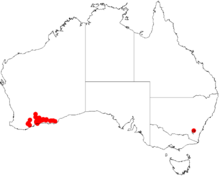Acacia binata
| Acacia binata | |
|---|---|
| Scientific classification | |
| Kingdom: | Plantae |
| Clade: | Tracheophytes |
| Clade: | Angiosperms |
| Clade: | Eudicots |
| Clade: | Rosids |
| Order: | Fabales |
| Family: | Fabaceae |
| Subfamily: | Caesalpinioideae |
| Clade: | Mimosoid clade |
| Genus: | Acacia |
| Species: | A. binata
|
| Binomial name | |
| Acacia binata | |

| |
| Occurrence data from AVH | |
Acacia binata is a shrub belonging to the genus Acacia and the subgenus Phyllodineae endemic to Western Australia.
Description
[edit]The dense, domed and spreading shrub typically grows to a height of 0.25 to 1 metre (1 to 3 ft).[1] The fleshy, flat, green phyllodes are slightly depressed to planoconvex in shape with a length of 8 to 17 mm (0.31 to 0.67 in) and a width of 1 to 1.5 mm (0.039 to 0.059 in) with three obscure nerves.[2] It blooms from August to October and produces yellow flowers.[1] The inflorescences are situated on two-headed racemes that have a 0.5 to 2 mm (0.020 to 0.079 in) long axes. The spherical flower-heads have a diameter of 3 to 3.5 mm (0.12 to 0.14 in) and contain between ten and twenty golden flowers. The black seed pods that form after flowering and often curved or irregularly coiled and have a length of around 3.5 cm (1.4 in) and a width of 3 to 3.5 mm (0.12 to 0.14 in). The grey to grey-brown seeds inside have an oblong-elliptic to ovate shape with a length of 2.5 to 3 mm (0.098 to 0.118 in).[2]
Distribution
[edit]It has a discontinuous distribution and is native to an area in the Wheatbelt, Goldfields-Esperance and Great Southern regions of Western Australia where it is found in low-lying areas an undulating plains growing in rocky clay-loam soils.[1] It is found from around Ongerup in the west to around Mount Beaumont which is around 90 km (56 mi) north of Esperance.[2]
See also
[edit]References
[edit]- ^ a b c "Acacia binata". FloraBase. Western Australian Government Department of Biodiversity, Conservation and Attractions.
- ^ a b c "Acacia binata". World Wide Wattle. Western Australian Herbarium. Retrieved 28 March 2019.
